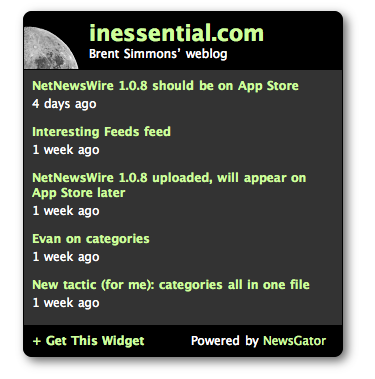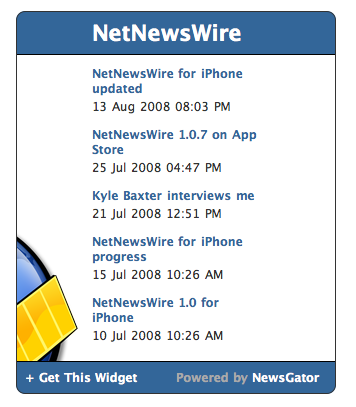Nick Harris’s DNC photos and videos
I wish I could have been there for the DNC — but I’ve been totally enjoying my co-worker Nick Harris’s photos and video. Thanks, Nick!
I wish I could have been there for the DNC — but I’ve been totally enjoying my co-worker Nick Harris’s photos and video. Thanks, Nick!
NewsGator’s widgets business hasn’t overlapped with NetNewsWire, but I felt like learning more about it. (I take it as self-evident that it’s good to be curious about your own company’s products.)
Some other parts of NewsGator’s business, especially NewsGator Enterprise Server (NGES), have overlapped with NetNewsWire. NetNewsWire and the other client apps work with NGES as well as with the online syncing system. (NGES is like the online system, but with a whole bunch of special features that businesses need.)
But I didn’t know that much about widgets, and I got curious. I got curious more about widgets-as-software than widgets-as-business, but I’ll talk about the business part first.
They’re web-page widgets, not Dashboard widgets or whatever they’re called in Windows. They embed in a page via JavaScript includes. Though widgets could be anything, NewsGator’s tend to display RSS feeds.
They’re also what the business hepcats like to call “viral” — they can spread. If you see a widget you like, you can add it to your own weblog, social networking thing, whatever.
Why would anyone make a widget? I can guess at some business uses:
Get the word out about your site.
Get more people to visit your site.
Make money from advertising. You could include an ad in a widget.
The more a widget spreads, the better you do with the above. Since anybody can spread a widget, I will guess that an important goal of a widget-maker is to make widgets that people want to spread.
Here’s where it got more interesting for me — I wondered what it was like to build a widget. I’m a developer, after all: I like making things.
Business hipsters call this the “self-serve” model — NewsGator doesn’t have to make every widget by hand: we provide the tools to make widgets and the system to run them. (We do make some widgets, but other people can make widgets too.)
We have a web app called Editor’s Desk where you can build a widget. You can add content from one or more feeds, and there are templates that let you pick the look and feel. Advanced users can edit the HTML, CSS, and JavaScript.
I decided right away that I was one of those advanced-user-snobs. (Chianti-drinking, Plato-quoting, CSS-editing…)
So I started futzing around to see what I could make, and at the same time I tried to figure out the basic principles of widget design. (Which is what most geeks would do, since it’s never enough to just learn how to make a thing: we have to get under the hood.)
I wondered if the widget design tools were flexible enough for me to create a widget that looked like my weblog. Answer: yes.
Here’s a screenshot, since the actual widget might not make it through your RSS reader.

(You can view the live, running widget.)
Then I did a widget that people might actually want to spread: it displays the NetNewsWire news feed. Here’s a screenshot:

(Again, the live version is on my widgets page.)
By this time I’d figured out a few things about widget design.
Seems obvious, but worth noting. Rounded corners are nearly a must.
This said to me that keeping resources low is a good idea. My widgets all use just one graphic. They don’t even use graphics for the rounded corners — they use the support built into Firefox and Safari for rounded corners. (You get square corners on IE, but I was willing to make the trade-off.)
For each widget I used a limited color palette. News items are separated by space rather than with bullets or lines. The one graphic I use adds visual interest plus a clue to what the widget is about. (Business daddy-Os would call the graphic a “branding” thing.)
I could have also added a mini-toolbar for each item, with an email-this link and a place to rate the article. But I didn’t quite buy the workflow, that you’d open a page, read it, and then come back, find the link on the widget, then email or it or rate it. I think you’re going to email a page when you’re actually on the page, either via a link on that page or your browser’s email command. And I didn’t think you’d remember that you want to come back and rate the page. Not including the mini-toolbar meant I had room to display more news items, and the overall look was more clear.
It’s like so many other things — desktop apps, web pages — with a header, main content area, and footer.
To keep things simple (and, I hope, more striking, better able to compete with other things on the page), my headers and footers are always the same background color, and they’re darker than the news items list (the lighter news items list helps with readability).
I’m sure there are more things to know about widget design, but I've only made a few so far, and I haven’t seen them running on other sites yet, so I’m just a newbie.
Now I was on a roll — making widgets is fun, it turns out — so I made a multi-feed widget: Seattle Mac & iPhone Developers. Here’s a screenshot:

And I made one last widget with news from the weblogs of some of my co-workers. (I know about the weblogs of J. B. Holston, Greg Reinacker, Jeff Nolan, Karyn German, Walker Fenton, Dan Larson, Nick Harris, and Nick Bradbury. Apologies to anybody whose weblog I don’t know about. ;)
(I’ve already posted enough screenshots — BRENTSCOWRKRSBLOGSOMG appears on my widgets page.)
I just got word that NetNewsWire 1.0.8 should be hitting the App Store — if it’s not there yet, it should be soon. (I believe.)
When I decided to remove the Sites Drawer from future versions of NetNewsWire, I replaced it with something else: a feed that lists interesting feeds that I find.
It’s called, simply, the Interesting Feeds feed. You can subscribe.
![]()
I thought about doing other things — loading OPML files written by other people into the Sites Drawer, for instance. But every idea like this meant a bunch of work for little benefit — and a big part of the reason to delete features is to be able to spend more time working on the features that matter most.
(Aside: people who don’t write software generally underestimate how much work a given feature takes. People who write just a little software — scripters, for instance — underestimate even worse.)
![]()
So, finally, I decided to go with writing a feed. It has the advantage of being low-tech — I don’t have to build anything new. I use MarsEdit to add items to the feed (since it’s just a category on ranchero.com). And there aren’t any deadlines or pressure. I just post whenever I want to.
I’m considering making it a default for new users (for NetNewsWire/Macintosh), though I haven’t decided yet.
![]()
Suggestions for the feed are, of course, welcome. I won’t use everything I get. Probably not even half or even a quarter. And it’s not a self-promotion thing: don’t tell me about your feed, tell me about some other interesting feed.
(If you tell me about your feed, I’ll tell my cat on you, and he’ll make long red ribbons of your skin, then eat parts of you that are supposed to stay inside you. Just a warning. ;)
I just uploaded NetNewsWire for iPhone 1.0.8 — I can’t say when it will appear on the App Store, of course, but it’s in the review process now.
Changes in 1.0.8 (since 1.0.7):
- Fixed a hang/crash at startup affecting some people.
- Fixed a bug restoring a feed or post at startup -- it now makes sure the feed and post still exist in the database.
- Removed the Feeds title and the horizontal stripes from the startup image, so it doesn't look like it's switching views at startup.
- Removed some logging code for when a download fails -- it shouldn't have been left in there.
- No longer showing title in navigation controller in news item detail view -- it was redundant, and it didn't hardly ever fit anyway.
- You can turn off the unread badge count on the home screen via a pref in Settings. (Note: the change in pref doesn't take effect until you next launch NetNewsWire.)
- Fixed a bug parsing dates in news items on systems with non-English date formatting. (It will fix dates for items in the future, but it can't fix existing wrong dates.)
Evan DiBiase writes that “if you’re only using a method in once place, you have no idea how it’s going to generalize. Maybe you can reuse it, as-is, in many other places. Perhaps it will need to be decomposed.”
Despite the previous post, I still do use categories. ;) They’re not banned-in-BrentLand.
For the iPhone version of NetNewsWire, I put them all in one file: NNWExtras.m. (“Extras” instead of Categories because there are also a few C functions and one macro defined in that file.)
What I like about this is the discipline it brings. I don’t want that one file to become big, so I’m more reluctant to add a category or category method.
I used to create categories too often, and I’ve cut way back.
One of the rules I’ve given myself: if something is used just once, don’t make a category for it, just make it a static C function. Unless it’s big.
![]()
Here’s a case of big: I use base64 decoding in just one place, but I still have my base64 code in an NSData category. Just because it’s big, it’s not some small function.
![]()
Here’s a case of small: I had a category for NSAppleEventDescriptor with one method, to get a target descriptor for a running app, given the path to the app. This was used in exactly one place (where the send-to-weblog command is implemented).
So what I did was turn that method into a static C function, and I put it in the same file where it’s used. (Which allowed me to get rid of my NSAppleEventDescriptor category file.)
The benefits I get from that:
1. Less code to maintain. (And, in this case, two fewer files: one deleted .h and one deleted .m.)
2. The code appears where it’s used: no need to jump to it if I need to edit it.
My instincts are always to lower the number of lines of code (and number of files) I have to maintain, so I consider this a good rule. But I wonder what other folks do in this case.
I had a great time at iPhoneDevCamp/Colorado over the weekend. Thanks to Joe Pezzillo and Danny Newman for putting this on!